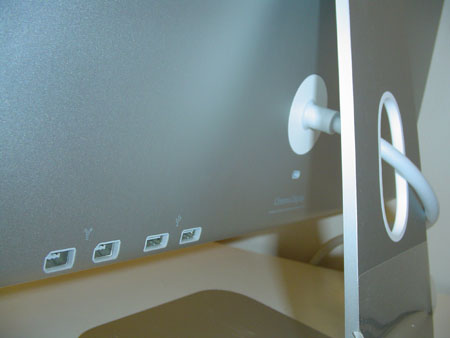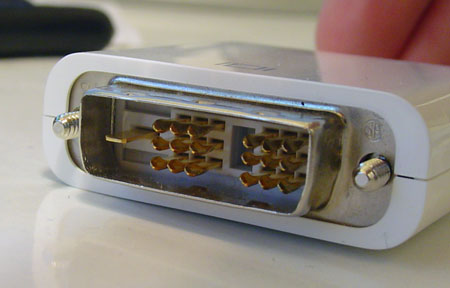The 20" LCD Shootout: Dell versus Apple
by Kristopher Kubicki on April 27, 2005 12:05 AM EST- Posted in
- Displays
Cable Management, Pivot, Stand
Cable management is very important to us, and Apple’s cable management might only be second to Samsung’s SyncMaster 193P or SyncMaster 172T. In fact, if you don’t mind the power brick, Apple might even excel past Samsung with this regard. Power, USB, Firewire and DVI signal are all transmitted via a single (proprietary) cable from the panel. The result is a very clean, no nonsense look that really complements the all aluminum bezel in only the best way possible.Dell takes the utilitarian approach to cable management and design on the 2005FPW. Although the result is still impressive, USB, D-sub, DVI, power, S-Video and composite cables all enter the unit separately. The 2005FPW does utilize several additional inputs when compared to the Apple Cinema 20”, but comparing one display against the other clearly puts Apple near the front. For those non-Mac users out there, don’t be scared by the strange DVI looking cable; this cable is backwards compatible with any PC DVI video card.
During our Dell 1905FP review from a few months ago, we took some flak for claiming that we were impressed by the USB inputs on the sides of the display. In fact, we do need to give credit to Apple for putting USB inputs on their original Cinema displays from several years ago. Dell deserves nearly as much credit for adding the convenience on one of the first widespread LCDs on the PC desktop, the Dell 2001FP. Dell offers two USB 2.0 inputs, which are now located on the right side of the display. The UltraSharp 2001FP and UltraSharp 19505FP had both inputs located on the left.
Apple takes a more subtle approach by locating their Firewire 400 and USB 2.0 inputs behind the bottom right of the panel. This was slightly awkward at first, and we actually ended up using a separate USB hub, since the hubs were very difficult to attach and detach easily. On the other hand, Apple gets points for including a Firewire 400 input, something that we were accustomed to quite quickly. Below, you can see the input set of the Dell 2005FPW.

Dell might not stack up to Apple as far as cable management goes, but how important is cable management compared to monitor flexibility? Flexibility is a term that we’ve had to coin over the last few display reviews for lack of a better word to describe how we can manipulate a monitor. Dell, in fact, allows us to rotate to 90 degrees counterclockwise, pivot to 90 degrees in either direction and tilt 45 degrees vertically. Several degrees of freedom are not something that we particularly lust for in a display, but they certainly have their functionality to some. ATI and NVIDIA both include pivot drivers in their latest driver packages, so pivoting can be enabled via the desktop control panel. For everybody else, Dell includes their own pivot drivers as well, although we had some difficulty getting these to work correctly on multiple display setups.












70 Comments
View All Comments
Weezard - Wednesday, May 4, 2005 - link
Okay, sounds good.So if I buy this monitor, Ill just have to plug it in, and it will work with widescreen and all - on my Windows XP system with 9700Pro?
Thanks.
Pastuch - Wednesday, May 4, 2005 - link
"Does my Radeon9700Pro support this monitor?"A 9700pro is an excellent videocard for this monitor if you dont plan on playing games like Halflife 2 or WoW. The 9700pro's DVI signal will work perfectly, however you should install the latest ATI driver from ATI.com.
"but what about resolution options, DDC (or what its called - the function that delivers 16:10 widescreen). "
DDC or whatever you had in mind does not deliver a widescreen display. If you install the latest ATI drivers you will see that the standard windows graphics profiles in display settings have 1680x1050x32. The ATI driver has the ability to force 720p or 1080i but it is not necessary.
Weezard - Wednesday, May 4, 2005 - link
Hi, nice review.I do have a few questions about the Cinema Display.
Does my Radeon9700Pro support this monitor? It has DVI output, but what about resolution options, DDC (or what its called - the function that delivers 16:10 widescreen).
Is this a plug and play monitor, when running Windows XP and Radeon 9700Pro? Is any software needed before using it with a Windows OS?
Thank you.
wrack - Wednesday, May 4, 2005 - link
One thing I forgot to ask Kristopher,Which graphics card and processor was used to carry out this review..? I can't find 1680x1050 resolution option on my graphics card.
wrack - Tuesday, May 3, 2005 - link
#54 Electonic circuits always tend to attract fine dust.nortexoid - Sunday, May 1, 2005 - link
dust acts as an insulator? the monitor is standing vertically so the only place dust would gather is on the top, not on any of the electronics. or do you lie your monitor face down on a glass desk and work from underneath the desk? i know it's gaining ergonomic popularity, but i thought only in malawi.Spacecomber - Saturday, April 30, 2005 - link
This is the kind of review that I'd like to see become the standard for comparing LCDs. Pick an assortment of LCDs that are using the same type of matrice panel(TN, IPS, PVA/MVA) and compare these monitors to each other. They don't have to be using the exact same panel, as in this case, just one based on the same technology. This will provide the reader with something much more like an apples to apples comparison than the apples to oranges comparision that you will get otherwise. (Sorry, about the Apple pun.)With all three (or four) types of matrices having such distinctive strengthes and weaknesses, you pretty much have to decide which of these patterns of characteristics will best match how you use the computer and then go looking for that particular type of matrice in a panel.
The questions for the reviewers then becomes how well does a particular display cope with it's inherent weaknesses, as well as how well does it emphasize what should be its relative strengths.
For example, in this Anandtech review of IPS panel displays, one of the main problems for IPS panels to overcome is a relatively low contrast ratio, which can affect how well it reproduces black; so, this specification is one that should be given particular attention in the review, especially the subjective analysis.
Response times are always a point of emphasis in LCD reviews, and with IPS screens, as was noted in the review, you should expect to see the relatively modest black-white response time made up for by the fact that response times stay relatively consistent, even when changes in shade become smaller. (That is why I was confused by this statement, regarding motion blur, in the review, "...two states that are very close to each other take less time than two states further apart from each other, which results in pixels that are not just delayed in a uniform manner, but at several different speeds across the entire panel depending on the hue". I thought that it was with states that were closer together that you saw the slower response time, due to the voltage differential being so small in these cases.)
In sum, I'd like to see more LCD reviews start with what is known about the panel that is being used (such as is detailed in this very good xbitlabs analysis, http://www.xbitlabs.com/articles/other/display/lcd... and use this understanding to provide a framework for comparing LCDs in terms of their strengths and weaknesses. Essentially, while there is no one LCD monitor that is as well rounded for many purposes as is a CRT, anyone buying a LCD will be looking for the one that imposes fewer compromises on the them and for compromises that impinge less on how the screen will be used by that particular buyer.
Space
KristopherKubicki - Friday, April 29, 2005 - link
nortexoid: Dust acts as an insulator. Wrapping your DSP in a warm cuddly blanket will probably make it fail prematurely.glennpratt: Unfortunately I cannot quite vouche for the fact that aluminum really acts as a heat sink on this display. The housing is completely smooth and does not really create additional surface area for heat dissapation. Aluminums ability to transfer heat well only helps if there is additional surface area for the sink to come in contact with air.
In reality, the reason why Apple can get away with a beveled design without any passive exhaust has more to do with the fact that the inverter is housed in a separate brick from the display. Samsung does this too in many of their high end displays.
Anyways - I think Apple just picked Aluminum for looks.
Kristopher
glennpratt - Friday, April 29, 2005 - link
The Apple is made of aluminum which may have affected their decision to leave out the vents (aluminum transfers heat much better the plastic.)nortexoid - Thursday, April 28, 2005 - link
What do you think damages a electronics more: dust falling on them or high temperatures?I'd rather vents in the back of my monitor to prevent higher temperatures than have it completely sealed to keep out that horribly destructive nuclear fallout.